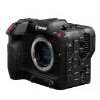
BrooklynDan
-
Posts
184 -
Joined
-
Last visited
Reputation Activity
-
 BrooklynDan got a reaction from tupp in Cooke factory tour 2020 by Jon Fauer
BrooklynDan got a reaction from tupp in Cooke factory tour 2020 by Jon Fauer
I played with Xtal Express and Technovision Cookes at my previous job. They have nothing in common with the new Cooke Anamorphics. The Cookes have pin-cushion distortion. The vertical lines bend inward. The older lenses have classic barrel distortion. Also, they were converted from spherical lenses, whereas the modern Cooke Anamorphics are purpose-built. And some of the cylinders are rotated 90 degrees which stretches the image out vertically, in addition to it being squeezed horizontally. They are also fairly consistent from focal length to focal length and color matched. JDCs were notoriously inconsistent.
Top one is Zeiss SS. Bottom one is Speed Panchro.
-
 BrooklynDan got a reaction from jgharding in Cooke factory tour 2020 by Jon Fauer
BrooklynDan got a reaction from jgharding in Cooke factory tour 2020 by Jon Fauer
I would like simpler lens designs to make a comeback in the cinema world. The large size and complex mechanics of most cinema glass is mainly to prevent breathing and chromatic aberration. Breathing correction accounts for half the size of the Master Primes for example. I find that unless you're shooting for a massive cinema screen, breathing isn't really too much of a problem unless you rack from infinity to close focus on a static shot. If you're shooting with a lot of camera movement, it's barely noticeable at all. And hell, considering how much is shot on older anamorphics these days, even big-budget blockbusters, breathing is clearly not the issue it used to be.
Also, I disagree with the tact many manufacturers have taken with adding "character" to their lenses after the fact. They build hyper-modern, ultra-sharp lenses and tweak the coatings for more flare and ghosting. The result doesn't look "vintage" to me at all. It's looks like a modern lens with flare superimposed on the image as if it was done in After Effects. Sigma is especially guilty of this. Their "Classics" are duds in my opinion.
The Cooke Classic Panchros are much more successful in this aspect. They actually replicate the small dimensions and steeply curved surfaces of lenses past and the result is much more pleasing. Hell, even their Cooke S4s are practically vintage now, even though they set the standard for cinema glass just 10-15 years ago. Compared to the new Zeiss and Leica glass, their fall-off, vignetting and flaring appear to be from a different era.
I also think that the obsession with fast apertures is driving the direction of lens design towards a clinical direction. Having a lens that's usable but pleasing at T1.4 requires twice the engineering, twice the size and twice the price as one that's T2. It's actually easier to build a lens that's clinically sharp at that stop (and much much easier to build a lens that's useless at that stop) than one that maintains focus while supplying an image with character and charm. See the Leica Summiluxes, Cooke S5is, or Vantage Ones. Previous generations of high speed primes (Zeiss Super Speeds, Canon K35s) were mush wide open.
Basically lens design =
A. Pleasing, vintage-style character
B. Crisp sharpness at WFO
C. Price
Pick only two. You can't have all three.
-
 BrooklynDan got a reaction from Emanuel in Cooke factory tour 2020 by Jon Fauer
BrooklynDan got a reaction from Emanuel in Cooke factory tour 2020 by Jon Fauer
Speaking of Lomos, there's a guy who did a group buy on Reduser for newly manufactured front elements for the 35mm Squarefront. Once he got enough people to commit, he got a Russian lens factory to do a run. He was quoting around $2000 a piece. Now let's say that you wanted to mass produce Lomos again. The squarefront has four cylindrical elements in 2 groups. Let's figure $1,500 per element since the higher the number, the lower the piece. That's $6K just in anamorphic glass. Add another grand for a simple spherical group in the back. The original was a copy of a Zeiss Distagon. Plus a rugged housing with synchronized dual focus mechanics in PL mount. Van Diemen Optics quotes 6300 pounds for a squarefront housing. Let's just call it $4K which is the lowest conceivable sum for a sturdy lens barrel with two different focus movements. That's $11,000 for a brand new Lomo Squarefront, and I'm being extremely conservative here. And you're still getting a lens with poor close focus, severe breathing, mumping and considerable falloff on the sides. Multiply by three for a complete set of 35mm, 50mm and 80mm lenses and that's $33,000. Now how much is a set of used Squarefronts these days?
The economics of anamorphic at work.
-
 BrooklynDan got a reaction from PannySVHS in Cooke factory tour 2020 by Jon Fauer
BrooklynDan got a reaction from PannySVHS in Cooke factory tour 2020 by Jon Fauer
I would like simpler lens designs to make a comeback in the cinema world. The large size and complex mechanics of most cinema glass is mainly to prevent breathing and chromatic aberration. Breathing correction accounts for half the size of the Master Primes for example. I find that unless you're shooting for a massive cinema screen, breathing isn't really too much of a problem unless you rack from infinity to close focus on a static shot. If you're shooting with a lot of camera movement, it's barely noticeable at all. And hell, considering how much is shot on older anamorphics these days, even big-budget blockbusters, breathing is clearly not the issue it used to be.
Also, I disagree with the tact many manufacturers have taken with adding "character" to their lenses after the fact. They build hyper-modern, ultra-sharp lenses and tweak the coatings for more flare and ghosting. The result doesn't look "vintage" to me at all. It's looks like a modern lens with flare superimposed on the image as if it was done in After Effects. Sigma is especially guilty of this. Their "Classics" are duds in my opinion.
The Cooke Classic Panchros are much more successful in this aspect. They actually replicate the small dimensions and steeply curved surfaces of lenses past and the result is much more pleasing. Hell, even their Cooke S4s are practically vintage now, even though they set the standard for cinema glass just 10-15 years ago. Compared to the new Zeiss and Leica glass, their fall-off, vignetting and flaring appear to be from a different era.
I also think that the obsession with fast apertures is driving the direction of lens design towards a clinical direction. Having a lens that's usable but pleasing at T1.4 requires twice the engineering, twice the size and twice the price as one that's T2. It's actually easier to build a lens that's clinically sharp at that stop (and much much easier to build a lens that's useless at that stop) than one that maintains focus while supplying an image with character and charm. See the Leica Summiluxes, Cooke S5is, or Vantage Ones. Previous generations of high speed primes (Zeiss Super Speeds, Canon K35s) were mush wide open.
Basically lens design =
A. Pleasing, vintage-style character
B. Crisp sharpness at WFO
C. Price
Pick only two. You can't have all three.
-
 BrooklynDan got a reaction from andrgl in Cooke factory tour 2020 by Jon Fauer
BrooklynDan got a reaction from andrgl in Cooke factory tour 2020 by Jon Fauer
I played with Xtal Express and Technovision Cookes at my previous job. They have nothing in common with the new Cooke Anamorphics. The Cookes have pin-cushion distortion. The vertical lines bend inward. The older lenses have classic barrel distortion. Also, they were converted from spherical lenses, whereas the modern Cooke Anamorphics are purpose-built. And some of the cylinders are rotated 90 degrees which stretches the image out vertically, in addition to it being squeezed horizontally. They are also fairly consistent from focal length to focal length and color matched. JDCs were notoriously inconsistent.
Top one is Zeiss SS. Bottom one is Speed Panchro.
-
 BrooklynDan got a reaction from Andrew Reid in Cooke factory tour 2020 by Jon Fauer
BrooklynDan got a reaction from Andrew Reid in Cooke factory tour 2020 by Jon Fauer
I played with Xtal Express and Technovision Cookes at my previous job. They have nothing in common with the new Cooke Anamorphics. The Cookes have pin-cushion distortion. The vertical lines bend inward. The older lenses have classic barrel distortion. Also, they were converted from spherical lenses, whereas the modern Cooke Anamorphics are purpose-built. And some of the cylinders are rotated 90 degrees which stretches the image out vertically, in addition to it being squeezed horizontally. They are also fairly consistent from focal length to focal length and color matched. JDCs were notoriously inconsistent.
Top one is Zeiss SS. Bottom one is Speed Panchro.
-
 BrooklynDan got a reaction from TomTheDP in Canon will be announcing a new Cinema EOS camera ahead of NAB in April
BrooklynDan got a reaction from TomTheDP in Canon will be announcing a new Cinema EOS camera ahead of NAB in April
I work (and have worked) in multiple rental houses that have rented to all types of productions. Easyrigs get rented a lot, but mostly to commercials and branded content. They work great for getting that spontaneous, free-floating handheld look, shot-from-the-hip style that's prevalent now in ads, both on TV and stuff that get's aired on Youtube. It's also great for documentary work, since it allows to hold the camera for much longer periods of time. 20, 30, 40 minute handheld takes become much easier with an Easyrig.
For actual dramatic, narrative material, easyrigs are used much less. Dramatic cinematography relies on the ability to control your frame and land precisely on marks. This is really hard to do with an Easyrig because it tends to swing the camera when you turn. Also, extended handheld tracking shots are impossible because when you walk with an Easyrig, the motion from your hips gets transmitted through the arm and is visible in the footage. There is a use for the Easyrig for helping with low-angle handheld shots with really heavy rigs (such as Alexa 65, or Venice with certain anamorphic lenses), but the standard in handheld cinematography is a well-balanced camera on the shoulder and a pair of strong hands either holding grips, or the mattebox.
-
 BrooklynDan got a reaction from barefoot_dp in Canon will be announcing a new Cinema EOS camera ahead of NAB in April
BrooklynDan got a reaction from barefoot_dp in Canon will be announcing a new Cinema EOS camera ahead of NAB in April
I work (and have worked) in multiple rental houses that have rented to all types of productions. Easyrigs get rented a lot, but mostly to commercials and branded content. They work great for getting that spontaneous, free-floating handheld look, shot-from-the-hip style that's prevalent now in ads, both on TV and stuff that get's aired on Youtube. It's also great for documentary work, since it allows to hold the camera for much longer periods of time. 20, 30, 40 minute handheld takes become much easier with an Easyrig.
For actual dramatic, narrative material, easyrigs are used much less. Dramatic cinematography relies on the ability to control your frame and land precisely on marks. This is really hard to do with an Easyrig because it tends to swing the camera when you turn. Also, extended handheld tracking shots are impossible because when you walk with an Easyrig, the motion from your hips gets transmitted through the arm and is visible in the footage. There is a use for the Easyrig for helping with low-angle handheld shots with really heavy rigs (such as Alexa 65, or Venice with certain anamorphic lenses), but the standard in handheld cinematography is a well-balanced camera on the shoulder and a pair of strong hands either holding grips, or the mattebox.
-
 BrooklynDan got a reaction from independent in Canon will be announcing a new Cinema EOS camera ahead of NAB in April
BrooklynDan got a reaction from independent in Canon will be announcing a new Cinema EOS camera ahead of NAB in April
I work (and have worked) in multiple rental houses that have rented to all types of productions. Easyrigs get rented a lot, but mostly to commercials and branded content. They work great for getting that spontaneous, free-floating handheld look, shot-from-the-hip style that's prevalent now in ads, both on TV and stuff that get's aired on Youtube. It's also great for documentary work, since it allows to hold the camera for much longer periods of time. 20, 30, 40 minute handheld takes become much easier with an Easyrig.
For actual dramatic, narrative material, easyrigs are used much less. Dramatic cinematography relies on the ability to control your frame and land precisely on marks. This is really hard to do with an Easyrig because it tends to swing the camera when you turn. Also, extended handheld tracking shots are impossible because when you walk with an Easyrig, the motion from your hips gets transmitted through the arm and is visible in the footage. There is a use for the Easyrig for helping with low-angle handheld shots with really heavy rigs (such as Alexa 65, or Venice with certain anamorphic lenses), but the standard in handheld cinematography is a well-balanced camera on the shoulder and a pair of strong hands either holding grips, or the mattebox.
-
 BrooklynDan got a reaction from ade towell in Canon will be announcing a new Cinema EOS camera ahead of NAB in April
BrooklynDan got a reaction from ade towell in Canon will be announcing a new Cinema EOS camera ahead of NAB in April
I work (and have worked) in multiple rental houses that have rented to all types of productions. Easyrigs get rented a lot, but mostly to commercials and branded content. They work great for getting that spontaneous, free-floating handheld look, shot-from-the-hip style that's prevalent now in ads, both on TV and stuff that get's aired on Youtube. It's also great for documentary work, since it allows to hold the camera for much longer periods of time. 20, 30, 40 minute handheld takes become much easier with an Easyrig.
For actual dramatic, narrative material, easyrigs are used much less. Dramatic cinematography relies on the ability to control your frame and land precisely on marks. This is really hard to do with an Easyrig because it tends to swing the camera when you turn. Also, extended handheld tracking shots are impossible because when you walk with an Easyrig, the motion from your hips gets transmitted through the arm and is visible in the footage. There is a use for the Easyrig for helping with low-angle handheld shots with really heavy rigs (such as Alexa 65, or Venice with certain anamorphic lenses), but the standard in handheld cinematography is a well-balanced camera on the shoulder and a pair of strong hands either holding grips, or the mattebox.
-
 BrooklynDan got a reaction from tupp in Camera company staff dramas on GlassDoor
BrooklynDan got a reaction from tupp in Camera company staff dramas on GlassDoor
Newsflash: Almost every large company is run like this. Once a company achieves a certain scale, old school management principles come into play. A strict hierarchy is established and innovative minds tend to get pushed to the bottom. Companies are run by MBAs, not by camera nerds. Small start-ups can run a bit leaner and display truly innovative and disruptive behavior. But that only lasts until it's sold off or becomes a key player in the industry. Then the dogs start chewing at each other.
About Black Magic, I appreciate the image quality on both the Pocket 6k and the Ursa Mini. But the so-called "industrial design" is pretty atrocious and the build quality still leaves a lot to be desired. They would do well to charge a few thousand more and equip their camera with fully aluminum bodies, so that they stand up better to on-set use. And the Pocket has the worst form factor of any camera on the planet. No amount of cages, rigs or battery plates can turn it into a functional piece of cinema equipment. It's like a camera designed by an ancient Egyptian who'd only seen a camera in hieroglyphs.
-
 BrooklynDan got a reaction from ntblowz in Camera company staff dramas on GlassDoor
BrooklynDan got a reaction from ntblowz in Camera company staff dramas on GlassDoor
Newsflash: Almost every large company is run like this. Once a company achieves a certain scale, old school management principles come into play. A strict hierarchy is established and innovative minds tend to get pushed to the bottom. Companies are run by MBAs, not by camera nerds. Small start-ups can run a bit leaner and display truly innovative and disruptive behavior. But that only lasts until it's sold off or becomes a key player in the industry. Then the dogs start chewing at each other.
About Black Magic, I appreciate the image quality on both the Pocket 6k and the Ursa Mini. But the so-called "industrial design" is pretty atrocious and the build quality still leaves a lot to be desired. They would do well to charge a few thousand more and equip their camera with fully aluminum bodies, so that they stand up better to on-set use. And the Pocket has the worst form factor of any camera on the planet. No amount of cages, rigs or battery plates can turn it into a functional piece of cinema equipment. It's like a camera designed by an ancient Egyptian who'd only seen a camera in hieroglyphs.
-
 BrooklynDan got a reaction from heart0less in Camera company staff dramas on GlassDoor
BrooklynDan got a reaction from heart0less in Camera company staff dramas on GlassDoor
Newsflash: Almost every large company is run like this. Once a company achieves a certain scale, old school management principles come into play. A strict hierarchy is established and innovative minds tend to get pushed to the bottom. Companies are run by MBAs, not by camera nerds. Small start-ups can run a bit leaner and display truly innovative and disruptive behavior. But that only lasts until it's sold off or becomes a key player in the industry. Then the dogs start chewing at each other.
About Black Magic, I appreciate the image quality on both the Pocket 6k and the Ursa Mini. But the so-called "industrial design" is pretty atrocious and the build quality still leaves a lot to be desired. They would do well to charge a few thousand more and equip their camera with fully aluminum bodies, so that they stand up better to on-set use. And the Pocket has the worst form factor of any camera on the planet. No amount of cages, rigs or battery plates can turn it into a functional piece of cinema equipment. It's like a camera designed by an ancient Egyptian who'd only seen a camera in hieroglyphs.
-
 BrooklynDan got a reaction from tweak in Camera company staff dramas on GlassDoor
BrooklynDan got a reaction from tweak in Camera company staff dramas on GlassDoor
Newsflash: Almost every large company is run like this. Once a company achieves a certain scale, old school management principles come into play. A strict hierarchy is established and innovative minds tend to get pushed to the bottom. Companies are run by MBAs, not by camera nerds. Small start-ups can run a bit leaner and display truly innovative and disruptive behavior. But that only lasts until it's sold off or becomes a key player in the industry. Then the dogs start chewing at each other.
About Black Magic, I appreciate the image quality on both the Pocket 6k and the Ursa Mini. But the so-called "industrial design" is pretty atrocious and the build quality still leaves a lot to be desired. They would do well to charge a few thousand more and equip their camera with fully aluminum bodies, so that they stand up better to on-set use. And the Pocket has the worst form factor of any camera on the planet. No amount of cages, rigs or battery plates can turn it into a functional piece of cinema equipment. It's like a camera designed by an ancient Egyptian who'd only seen a camera in hieroglyphs.
-
 BrooklynDan got a reaction from Dunjoye in Camera company staff dramas on GlassDoor
BrooklynDan got a reaction from Dunjoye in Camera company staff dramas on GlassDoor
Newsflash: Almost every large company is run like this. Once a company achieves a certain scale, old school management principles come into play. A strict hierarchy is established and innovative minds tend to get pushed to the bottom. Companies are run by MBAs, not by camera nerds. Small start-ups can run a bit leaner and display truly innovative and disruptive behavior. But that only lasts until it's sold off or becomes a key player in the industry. Then the dogs start chewing at each other.
About Black Magic, I appreciate the image quality on both the Pocket 6k and the Ursa Mini. But the so-called "industrial design" is pretty atrocious and the build quality still leaves a lot to be desired. They would do well to charge a few thousand more and equip their camera with fully aluminum bodies, so that they stand up better to on-set use. And the Pocket has the worst form factor of any camera on the planet. No amount of cages, rigs or battery plates can turn it into a functional piece of cinema equipment. It's like a camera designed by an ancient Egyptian who'd only seen a camera in hieroglyphs.
-
 BrooklynDan got a reaction from Mako Sports in Camera company staff dramas on GlassDoor
BrooklynDan got a reaction from Mako Sports in Camera company staff dramas on GlassDoor
Newsflash: Almost every large company is run like this. Once a company achieves a certain scale, old school management principles come into play. A strict hierarchy is established and innovative minds tend to get pushed to the bottom. Companies are run by MBAs, not by camera nerds. Small start-ups can run a bit leaner and display truly innovative and disruptive behavior. But that only lasts until it's sold off or becomes a key player in the industry. Then the dogs start chewing at each other.
About Black Magic, I appreciate the image quality on both the Pocket 6k and the Ursa Mini. But the so-called "industrial design" is pretty atrocious and the build quality still leaves a lot to be desired. They would do well to charge a few thousand more and equip their camera with fully aluminum bodies, so that they stand up better to on-set use. And the Pocket has the worst form factor of any camera on the planet. No amount of cages, rigs or battery plates can turn it into a functional piece of cinema equipment. It's like a camera designed by an ancient Egyptian who'd only seen a camera in hieroglyphs.
-
 BrooklynDan got a reaction from IronFilm in Camera company staff dramas on GlassDoor
BrooklynDan got a reaction from IronFilm in Camera company staff dramas on GlassDoor
Newsflash: Almost every large company is run like this. Once a company achieves a certain scale, old school management principles come into play. A strict hierarchy is established and innovative minds tend to get pushed to the bottom. Companies are run by MBAs, not by camera nerds. Small start-ups can run a bit leaner and display truly innovative and disruptive behavior. But that only lasts until it's sold off or becomes a key player in the industry. Then the dogs start chewing at each other.
About Black Magic, I appreciate the image quality on both the Pocket 6k and the Ursa Mini. But the so-called "industrial design" is pretty atrocious and the build quality still leaves a lot to be desired. They would do well to charge a few thousand more and equip their camera with fully aluminum bodies, so that they stand up better to on-set use. And the Pocket has the worst form factor of any camera on the planet. No amount of cages, rigs or battery plates can turn it into a functional piece of cinema equipment. It's like a camera designed by an ancient Egyptian who'd only seen a camera in hieroglyphs.
-
 BrooklynDan got a reaction from rainbowmerlin in Fuji should make a $2000 full frame cam
BrooklynDan got a reaction from rainbowmerlin in Fuji should make a $2000 full frame cam
A medium format video camera from Fuji would shut the game down. Even though, it would be a pretty impractical format with limited lens choice compared to Super 35 or full frame, cinematographers think with their hearts as well as their brains, and getting the opportunity to shoot on a nearly IMAX-sized sensor would override a lot of other considerations.
Do it, Fuji. DO IT.
-
 BrooklynDan got a reaction from rainbowmerlin in Fuji should make a $2000 full frame cam
BrooklynDan got a reaction from rainbowmerlin in Fuji should make a $2000 full frame cam
I'd prefer if they released a dedicated cinema camera instead. It's easy to forget that Fuji has over a half century of experience making motion picture stocks. They were Kodak's main competition. Their Vivida daylight stocks were gorgeous. Deep rich colors and solid velvety blacks with warm lovely skin tones. Sadly, they no longer produce film stock, but bringing that look and feel to a digital cinema camera would be an amazing coda to that legacy.
I also think that Fuji's ergonomic sense work translate very well to a video camera. They have a charming analog feel to all their cameras, which is something that is sorely missing from most low cost video cameras today.
-
 BrooklynDan got a reaction from Mako Sports in Fuji should make a $2000 full frame cam
BrooklynDan got a reaction from Mako Sports in Fuji should make a $2000 full frame cam
I do not understand why people are so enamored of the mirrorless form factor. It is an option, but is it the ideal shape for a cinema camera? No. Wouldn't you rather have a camera shaped like a proper camera, at least one that is longer than it is wide? I've been working in rental houses for years, and when it comes to ACs and camera operators, speed and reliability is key
An Alexa Mini or a Venice works beautifully with every imaginable accessory. You can rig it up with a Preston, Cine Tape, Teradek, multiple on board monitors and the matte box of your choice without breaking a sweat. There's ample room on the camera body and lots of options for power outputs.
Do people rig up A7s and GH5s and 5Ds like that? Yes. But it's a struggle and you wind up fighting against the thing. It's not designed to be used like that. It's designed to be held up to your eye so that you can snap a picture. No amount of Log profiles or Raw outputs will change that.
-
 BrooklynDan got a reaction from Mako Sports in Fuji should make a $2000 full frame cam
BrooklynDan got a reaction from Mako Sports in Fuji should make a $2000 full frame cam
The GFX 100 is not a cinema camera. It is a mirrorless stills camera with video capabilities. Which is fine for one-man-bands or C-camera use on a set. But it's not a cinema camera like a C300 or FS7. The form factor is different. It's not suitable for use by a camera crew with remote follow focus, wireless video, on-board monitors, etc.
-
 BrooklynDan got a reaction from IronFilm in Fuji should make a $2000 full frame cam
BrooklynDan got a reaction from IronFilm in Fuji should make a $2000 full frame cam
I do not understand why people are so enamored of the mirrorless form factor. It is an option, but is it the ideal shape for a cinema camera? No. Wouldn't you rather have a camera shaped like a proper camera, at least one that is longer than it is wide? I've been working in rental houses for years, and when it comes to ACs and camera operators, speed and reliability is key
An Alexa Mini or a Venice works beautifully with every imaginable accessory. You can rig it up with a Preston, Cine Tape, Teradek, multiple on board monitors and the matte box of your choice without breaking a sweat. There's ample room on the camera body and lots of options for power outputs.
Do people rig up A7s and GH5s and 5Ds like that? Yes. But it's a struggle and you wind up fighting against the thing. It's not designed to be used like that. It's designed to be held up to your eye so that you can snap a picture. No amount of Log profiles or Raw outputs will change that.
-
 BrooklynDan got a reaction from IronFilm in Fuji should make a $2000 full frame cam
BrooklynDan got a reaction from IronFilm in Fuji should make a $2000 full frame cam
The GFX 100 is not a cinema camera. It is a mirrorless stills camera with video capabilities. Which is fine for one-man-bands or C-camera use on a set. But it's not a cinema camera like a C300 or FS7. The form factor is different. It's not suitable for use by a camera crew with remote follow focus, wireless video, on-board monitors, etc.
-
 BrooklynDan got a reaction from Alt Shoo in Fuji should make a $2000 full frame cam
BrooklynDan got a reaction from Alt Shoo in Fuji should make a $2000 full frame cam
A medium format video camera from Fuji would shut the game down. Even though, it would be a pretty impractical format with limited lens choice compared to Super 35 or full frame, cinematographers think with their hearts as well as their brains, and getting the opportunity to shoot on a nearly IMAX-sized sensor would override a lot of other considerations.
Do it, Fuji. DO IT.
-
 BrooklynDan got a reaction from Mako Sports in Fuji should make a $2000 full frame cam
BrooklynDan got a reaction from Mako Sports in Fuji should make a $2000 full frame cam
A medium format video camera from Fuji would shut the game down. Even though, it would be a pretty impractical format with limited lens choice compared to Super 35 or full frame, cinematographers think with their hearts as well as their brains, and getting the opportunity to shoot on a nearly IMAX-sized sensor would override a lot of other considerations.
Do it, Fuji. DO IT.










